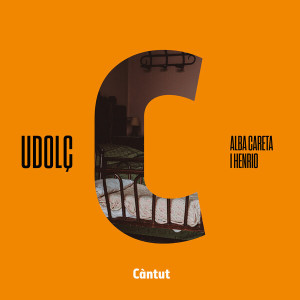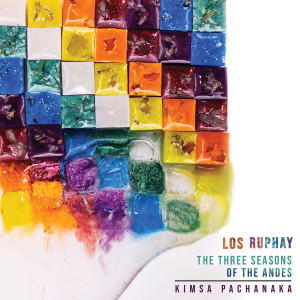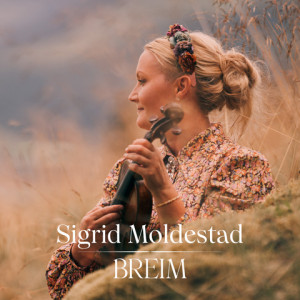Acclaimed Norwegian singer and songwriter Sigrid Moldestad’s sixth album on Grappa, seventh overall, is something different: Breim is a deep dive into her cultural heritage. And rather than playing and singing her own songs, she focuses this time on the folk traditions of Norway, in particular the Vestland region where she grew up in the village of Breim. This time out she mostly plays fiddle and Hardangfele, although she does sing occasionally. These 26 songs and tunes put her fiddling front and center, sometimes solo, sometimes with minimal accompaniment by a small cadre of top Norwegian folk musicians: Sigbjørn Apeland on harmonium, Torbjørn Netland on cittern, and Morten Skage on acoustic bass.
Most of the tunes are “trad. arr.” Moldestad. As she says, “This album is a collection of tunes I am particularly fond of, have discovered, and shaped based on my knowledge and experience of the tradition’s characteristics, rhythm, and tonality. I am grateful for all those who have played and sung these tunes before me.”
The first two tracks “Aamundspringaren” and “Gamalt” are solo fiddle and Hardanger, respectively, and I spent a few moments of dread thinking all 26 tracks would be like that. But fear not, there is greater variety here than that, though often subtly. In fact the third “Aa gjev eg hadde ei fela god” features her singing the lilting melody to the accompaniment of all three of the musicians named above plus her own violin, a tune she composed for lyrics by Absalon Steinsaaker. Here as everywhere else on this generous album the accompaniment is sensitive and focused on the song rather than showing off with solos or technique. Apeland’s touch on the harmonium throughout adds poignancy. Tender and solemn brides’ marches, sprightly polskas, hallings (an acrobatic solo men’s dance), and the popular Norwegian folk dance known as springar … you’ll find lots of examples here, all played with verve and soul. Highly recommended for fans of living, breathing Nordic traditional folk music.
(Heilo, 2023)
| Website | Instagram | Facebook |
 Udolç – Alba Careta and Henrio’s Càntut
Udolç – Alba Careta and Henrio’s Càntut
Càntut is the unique and beguiling project of Catalonian jazz trumpeter and singer Alba Careta and the singer-songwriter-producer Henrio, the duo performing under the name of Udolç. These are the songs (and spoken words) of a multimedia project that highlights the oral traditions of the Girona regions of Catalonia through lullabies the musicians have collected as they performed and researched there.
Lullabies they may be, but this is not a soporific album. The musicians describe it as, “Udolç, a project to put the little ones to sleep and awaken the curiosity of the elderly.” Both Alba Careta and Henrio sing, often together in harmonies both sweet and acidic, and she whistles and plays trumpet in ways both traditional and non-. Both Henrio and producer Santi Careta play guitars, and Santi provides soundscapes using instruments and analog synthesizers. What emerges is often dreamlike, sometimes startling and occasionally verging on nightmarish. To this are added occasional interludes in the form of four poems of night, sleep, and dreams, by Enric Casasses, which he recites himself in a delightfully craggy voice.
The most straightforward of the songs is “Non non,” a warm classical guitar accompanying the mother singing to quiet the “creatures” as the child sleeps. The lilting waltz “Sant Josep, feu-lo dormir” (Saint Joseph, make him sleep) blends the two singers’ voices beautifully, with musical interludes on horn and whistling. It’s the opening track and subject of a creative video.
Most of the others feature arrangements and soundscapes that at times belie the soothing lyrics of the lullabies. The sweet vocals on “La Dida” are set to ambient sounds that occasionally startle; “Sant Jaume del Corraló” has the singers accompanied only by a cajón-like percussive beat; “El noi de la mare” (Mother’s boy) has a slightly sinister feel from plucked violin and guitar, some dark harmonies, and subtle electronic effects. And “La mare de Déu” (Mother of God) has a portentous musical theater quality.
At once earthy and otherworldly, soothing yet vaguely troubling, the entire album of Càntut begs to be listened to late at night, after the little ones are abed, perhaps with a glass of rich red wine or a warm dark spirit like whisky or rum. Intriguing and wholly original.
(Segell Microscopi / Bankrobber, 2023)
 Johanna Juhola’s A Brighter Future
Johanna Juhola’s A Brighter Future
Finnish accordionist and composer Johanna Juhola’s fifth album A Brighter Future moves her into slightly new territory, exploring pop and electronic music blended with her usual folk-based music, but always firmly focused on her roots based accordion dance and folk music. It’s bright, sparkly music that sometimes reflects and more often belies the somber nature of some Nordic folk music.
On her previous outings Johola has been accompanied by either the members of her trio or the ensemble Reaktori, but this time all the members of both bands play. They are bassist Sara Puljula, percussionist Juuso Hannukainen, and harmonium player and pianist Oona Sinkko from Johanna Juhola Reaktori, and guitarist Roope Aarnio, and sound designer Teemu Korpipää (who also engineered and mixed this album) from Johanna Juhola Trio.
There’s an international flavor to the album as a whole, which is off to a very dance-oriented start with the straightforward march tune “Training Montage Quadrille,” then “Pachinko Sensei,” inspired by soundscapes encountered on tour in Japan, and the dance-floor friendly “Elektroniikkakerho” (Electronics Club). The first half ends with the warm and relaxed “Lähiökesä” (Suburban Summer) and from there the music takes on a more pensive note. The title track moves from troubled to hopeful; “Alarm” is a signature circus-like “fantasy tango” that’s a modified version of an experimental dance theater work called “Chess Piece,” and “Micro Wave + House Band” accompanies a short film in which the accordionist imagines her bandmates as her beeping home appliances. Throughout, Juhola’s music and the production are crisp and direct, recognizably Finnish, and consistently entertaining.
(Nordic Notes, 2023)
Senderos is technically a jazz album, but at its heart it’s very much folk and roots based. The group developed when double bassist Pau Lligadas was touring behind his leader debut, which was titled Madera Viva. The trio on the album included Lligadas on bass and vocals, with Vicenç Solsona on guitar and vocals, and internationally renowned Spanish multi-instrumentalist Jorge Rossy on drums; on tour Ramón Ángel Rey replaced the in-demand Rossy on drums, and the trio gelled sufficiently to take on its own project.
At times rubbing up against smooth jazz, particularly in the bossa and samba-tinged songs, elsewhere these players’ jazz credentials stand out, the rhythm section in particular. Rey and Lligadas find a deep groove on one of José Feliciano’s signature songs “Que Será,” with the bassist laying down a slapping solo. Ditto on the swinging “La curva del Morrot” by the late great Catalan rumba bassist Gato Pérez.
Jazz takes the front seat on Lligadas’ composition “Rápido Analógico,” on which the guitarist struts his technique and classic tone, with the rhythm section displaying remarkable attention and focus throughout, not to mention chops. Elsewhere folksy vocals take center stage, particularly on the opening track “Quan Era Petit,” which begins with a stirring a capella duet by Solsona and Lligadas. These two tenors have very sweet voices that blend well, but at times the arrangements and production veer close to easy listening or as I said smooth jazz. But if you’re looking for an album of sunny, warm, heartfelt songs in Spanish and Catalan, with standout jazz accompaniment, give Senderos a try. It’ll transport you somewhere warm and relaxing.
(Microscopi, 2023)
 Los Ruphay’s The Three Seasons Of The Andes
Los Ruphay’s The Three Seasons Of The Andes
Nearly everybody of roughly my generation (the Post War Baby Boomers) can probably tell you about the first time they heard the haunting indigenous music of the Andes. It was featured on the hit 1970 single “El Condor Pasa” from Simon & Garfunkel’s final studio album Bridge Over Troubled Water, played by the Paris-based Peruvian folk group Los Incas, also known as Urubamba. It was a beguiling sound made chiefly by the Andean panpipes known as sikus and small strummed lutes called charangos. Over the ensuing couple of decades the number of Andean pan pipe bands playing in the U.S. and internationally seemingly grew exponentially, and the music seemed to grow increasingly formulaic and passé.
But the Andean folk music was one of the first examples of what became World Music. Professional ensembles go back at least 50 years, and many continue to represent the unique cultures of Bolivia, Peru, Argentina and other Andean states. That holds true for Bolivians Los Ruphay (which means a ray of sunlight in Quechua), who released this live recording of music composed by their former leader, the late Mario P. Gutiérrez, to spread the message of the ways in which the Andean cultures are coping with climate change.
The music on The Three Seasons of the Andes highlights the three seasons of the Aymara annual cycle. The four tracks present music in long form suites, combining tunes composed by Gutiérrez interspersed with traditional tunes from the La Paz, Bolivia region. The players on charango, sikus, percussion, guitar and vocals are Basilio Huarachi, Goya Céspedes, Ramiro Calderón, Raúl Chalcon, and Willy Claure. As loaded as the word “authentic” is these days, the music here comes over as just that, a hearfelt presentation of the musicians’ cultural expression, minus the New Age trappings that it’s sometimes burdened with. It has a serious purpose but it’s performed with great joy that is uplifting.
(ARC Music, 2023)
| Website |


